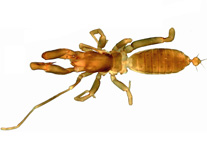Abstract
Laimaphalenchus hyrcanus n. sp., from bark samples of cypress (Cupressus sp.) and jujube (Ziziphus jujube Miller) from Gorgan, Golestan province in northern Iran, is described and illustrated based on morphological and molecular characters. The new species is characterized by females with 670–870 μm body length, slender stylet of 11–12 µm, six-lobed cephalic region not divided by ribs, three incisures in the lateral field with slightly areolated outer lines in the posterior region, cuticular vulval flap, males with two pairs of caudal papillae, and subcylindrical tail in both sexes ending in a single stalk-like terminus with four pedunculate tubercles bearing 9–10 finger-like projections. The new species most closely resembles L. persicus and L. penardi but it can be differentiated by its having three incisures in the lateral field and two pairs of caudal papillae in males. Molecular analysis of the D2/D3 region of the 28S ribosomal RNA gene indicates a sister-taxon relationship with L. penardi (Steiner, 1914) Filipjev & Schuurmans Stekhoven, 1941 and L. deconincki Elmiligy & Geraert, 1972.

